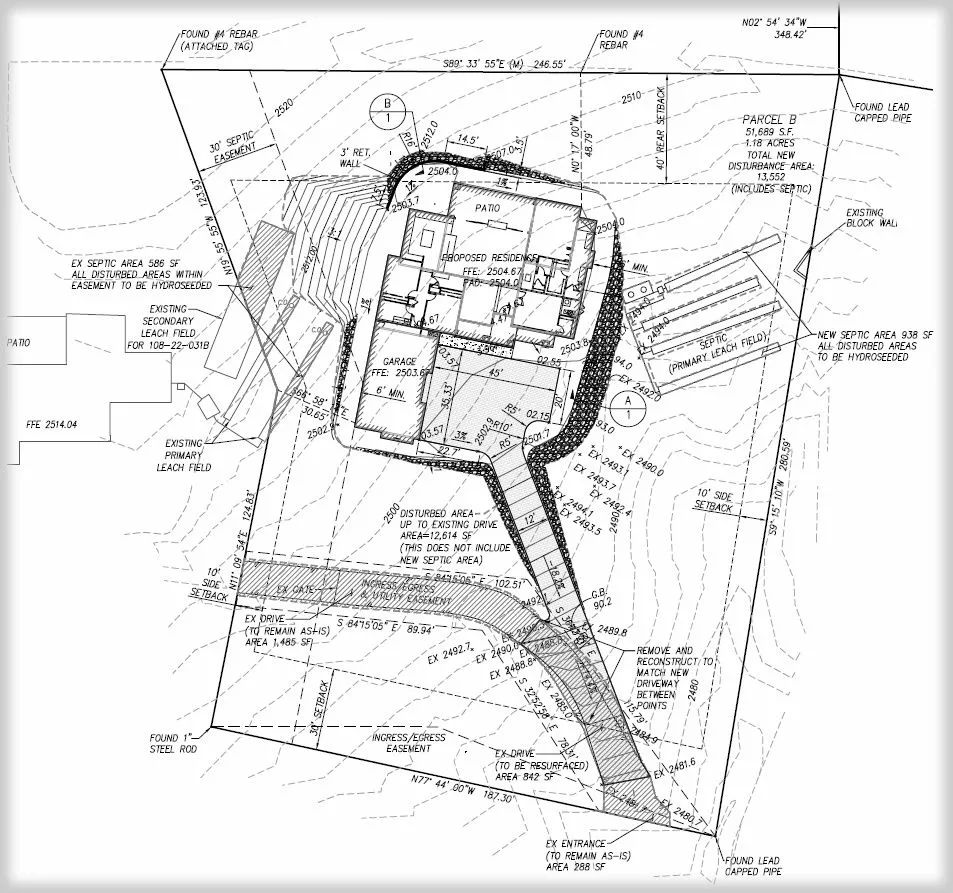What is Grading in Construction?
Do you know what is construction grading? and is it important to build a massive project?
Yes, It is very significant for the construction of any building. It increases property value up to the mark. The estimated land grading cost is 0.08$-2.00$. This is worth spending because it increases your property value up to the mark. A good constructor pays deep attention to land grading for the success of their project. To know the importance of grading, first, we must understand what is grading in construction.
Grade means level or class. So, what does grading mean in construction? It means a process to level the land’s surface to construct any project. Leveling the surface is necessary before starting a new project on any site. For this, the addition or removal of soil is required to maintain a proper drainage system and prevent destruction. This is not just to add or remove soil from the land. It requires many things to understand. So, let’s discuss about construction grading, its requirements, equipment and advantages.
What does grading mean in construction?
Construction grading is also known as site grading. As the name indicates, it is basically to get an equal surface for the site. This is the grading definition in construction.
With proper land grading, your project will be a tree with strong roots that can fall anytime. Poor grading can leads to:
- A weak drainage system can cause water leakage and destroy walls and roofs due to fungus production, water accumulation in the building, or any other problem.
- A poor foundation can cause cracks in the walls and even in the roof, collapses falling in case of any natural disaster.
- The unleveled foundation of any building causes the erosion of soil that can weaken the structure.
Hence, grading of the ground is the backbone of any construction project.
Types of Land grading:
Construction of different projects demands different types of grading. For example, the multi- and single-story construction demands different grading levels. Multi-story buildings need land that has the power to bear weight and require a robust drainage system that is possible with a leveled surface. Let’s discuss different types of land grading.
1. Rough Grading
This is the first grading level, which is done using high machinery like bulldozers. This step involves the removal of larger rocks, debris, plants, etc, from the ground. This is necessary to maintain the basic ground level.
2. Cut and Fill Grading
This type of grading is very beneficial. This involves the removal of soil from a higher surface and placing it on the lower surface to equal them both. This way, we can recycle the soil removed from the more elevated surface.
3. Slope Grading
Slope grading is the formation of a slope to facilitate the drainage system. Construction of some buildings requires a slope surface for a proper water flow. So, missing this grading can destroy your whole draining system.
4. Bench Grading
The bench grading is used in hilly areas. It is a process to level up a slope so that water does not run down due to gravity. These bench grades are designed and supported by a wall so that water movement does not cause soil erosion or harm vegetation.
5. Contour Grading
The counter grading aims to direct the water to a specific point for a proper flow to maintain the drainage system. It is a process to create rounded and stable lands or unaltered slopes on construction sites.
6. Fine Grading
This is the final step in leveling a surface. This involves the final leveling of the whole surface of your construction site. After this step, you can move forward to the next step of construction.
Is Grading Right for Your Construction Project? Talk to Our Engineers and Find Out.
Equipment Used for Grading:
Any equipment used for leveling a surface is known as a grader. Different types of graders are used for different types of land grading, like
Motor graders:
Motor graders are usually used in road construction and shaping canals.
Bulldozers and wheel tractor scrapers:
Bulldozers and wheel tractor scrapers are used to scrape and collect extra surface soil, debris, or any fixed plants on the land.
Skid steer loaders:
Skid steer loaders are used for digging and trenching purposes.
Why Grading is Important in Construction?
The grading of the earth plays a pivotal role in the foundational structure of a building. Following are some common advantages of grading.
Builds a Strong Foundation
A leveled and plain surface is necessary for the construction procedure. The compaction in grading makes the foundation strong so it can bear the weight of heavy concrete materials.
Proper Drainage System
The leveled ground becomes a requirement for the proper drainage system. In hilly areas with a surface that is too steep, grading makes it possible to flat the earth on equal level. Some sites require a slope grading to direct water in a specific direction.
Increase Property Value
Construction on a leveled land indicates that you follow all construction rules while constructing a building. This increases the value of your project.
Erosion Control
The graded lands prevent any disruption in the soil.
Aesthetic Landscaping
Leveled ground improved the landscape of a site. For example, it reduces maintenance costs, manages water storms, and reduces the risks of wall and roof cracks.
How to Develop Grading Plans?
Developing grading plans is very crucial. So, professionals proceed with it. The complete procedure is as under
Site Analysis
The first step is to survey the land on which you want construction. This step involves the proper survey of the land. The land surveyor analyzes the following points
- Land existing condition
- Required grading type for leveling up the earth
- Types of equipment needed for grading
Project Requirements
This step involves the thorough study of site and construction projects. The following questions must be included while compiling project requirements
- Is it a residential or commercial site?
- What are the basic needs of the project
- What are in the surroundings of the site
- What are the difficulties with the grading
- How does grading work affect the surroundings?
These questions will help you decide which plan to use for site grading.
Paperwork for Grading
Before starting work on the site, complete your paperwork. Build a complete strategy. A civil engineer usually plans this strategy. Grading planning consists of several documents containing all the information for grading on-site. Develop your plan in an easy way. The most recommended is the 3D illustration because it is easily readable by all the authorities and concerned persons.
Regulatory Compliance
It means following all the rules and regulations formed by the authorities of an area where you plan for land grading. Some substantial regulatory compliance is
Environmental Rules
Always make sure that you are following all the rules of environmental authority. Plan your grading in a way that does not cause environmental pollution.
Land Use Regulations
Make sure that the site on which you are planning land grading is according to the land usage ordinance of that area.The permit is required for grading of 5000 square feet land.
Safety Protocols for Workers
Always make safety protocols for the workers and apply them.
Surrounding Infrastructure Safety
Ensure your grading procedure will not affect any surrounding buildings and their systems.
Get Necessary NOCs
Always get necessary NOCs from the regulatory agencies such as environmental protection authorities, NOCs to use any software and tools, regulatory permission from the cultural and historical buildings, etc.The average cost to get NOC is 150$-485$. It varies from country to country.
Equipment Selection
Select your grading equipment carefully after analyzing your site because different equipment is used for different gradings. For details, you can read the equipment section of this blog.
Cut and Fill Operation
After equipment selection, you can start your grading procedure. You scratch soil from one piece and put it on another to equal their level. After that, the compaction procedure starts. Some people confuse compaction with grading land. But, these both are different. Compaction is the last stage of grading, where you press the soil heavily to increase the earth’s foundation.
Erosion Control Measures
To go with the erosion control measure, you must check the site condition, soil type, any plants present there, and the degree of possible erosion. Afterward, you can choose which measures to select for your grading procedure.
Two main parameters to control erosion are
- Geotextile fibers are used to seize the flow of water. They are tightly wrapped around the water bodies or other spots susceptible to soil erosion.
- The second way is Mulching. This uses synthetic fibers such as pipes and plastic sheets to protect the soil from water and wind.
Some safety measures that should be followed to prevent erosion are
- Never plan grading on rainy days.
- Always grade the minor portions.
- Try to complete your work on time so that your land stays exposed for a short time to prevent it from getting wet.
- Continuously monitor the land and do more grading, if necessary.
Final Inspection
This is the final step for your grading strategy and is very important, too. Because after that your construction work will start. So, monitor all steps and last ground. Make any necessary improvements.
Receive a preliminary site assessment for your grading project at a discounted rate.
How to read your Grading Plan?
A grading plan is usually a combination of complex documents that need to be readable by everyone. But, to make it understandable for everyone on the site, there are some crucial points.
- Grading plans are always in three-dimensional illustration.
- The x on the map indicates the precise elevations, while + IS is for proposed elevations.
- A general good grading plan also explains property lines, architectural plans, existing structures, utility grades, and drainage points.
How to Get Your Grading Plan Approved?
Getting approval before starting work on the site is very necessary. Usually, the city authorities approve your plan and consent for approval certification. Three main points should be considered to avoid any inconvenience during approval.
Lot Size
Officials in every city give an allowable size to cover. To get approval, you should follow this rule.
Earthwork Estimates
Authorities observe that your earthwork estimates are appropriate according to your task on site. So always mention your earthwork in your plan to avoid any rejection.
Underground Utilities
Ensure that your grading plan includes all the safety measures to prevent underground utilities such as pipes, drainage systems, vegetation, etc.
Conclusion
Many construction sites are rough and unequal. Such lands are not suitable for construction purposes. For these types of lands, we have to understand what is grading in construction?
We can make such lands useful for construction by land grading. Leveled land is the basic necessity of a substantial building. It improves land aesthetics and reduces the risks of preventing many natural disasters like earthquakes, water storms, etc.
So, grading of the earth is necessary before construction. For this, you need a proper strategy like a site visit, soil analysis, environmental conditions, surroundings infrastructure, etc. Always take regulatory measures before starting your site work, grading approved by relevant authorities, and managing all safety measures for your team.
FAQs:
Why is grading necessary in construction?
Land grinding is the foundation of any construction project. A strong foundation, erosion prevention, and proper drainage system are necessary for a company.
What is the difference between rough and finishing grading?
Rough grading is the first step of grading, which includes the removal of rocks, debris, and any vegetation while finishing grading is the last step of grading, which involves the compaction of the soil to make a strong and final base so that construction work can start.
What is the difference between leveling and grading?
Grading is a procedure to grade and level the whole site while leveling drops a specific area according to the rest of the land.
What is the difference between excavating and grading?
Excavation is digging or removing a specific portion of the earth to create space for foundations or underground construction processes while equally grading and leveling the world.
What are the common challenges in grading?
Grading is a complex process. The common challenges in grading are weather conditions, equipment selection, underground utilities, and vegetation.
Is a grading plan essential for every site?
No, Experts inspect the site and then decide whether a grading plan is essential for the construction site.
Can grading improve land aesthetics?
Yes, land aesthetics improved with grading. It can affect the site’s environmental, social, and economic aspects. For example, grading helps manage water storms, wildlife habitats, safety, and site maintenance costs.



